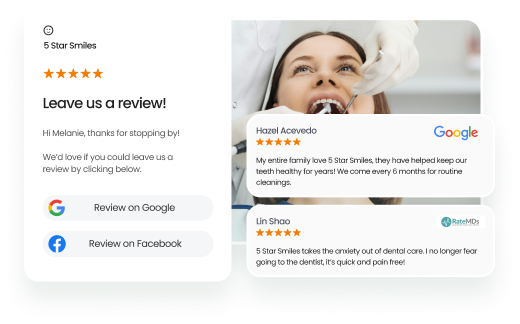Even with an outstanding medical practice, attracting new patients can be challenging if your website and local listings don’t rank on Google’s first page. According to Birdeye’s traffic analysis on core listing sites, over 83% of business traffic comes from Google, which means if you’re not visible, you’re missing out on potential appointments. That’s where doctor SEO techniques come in.
By implementing the right SEO strategies for doctors, you can improve search rankings, increase website traffic, and bring more patients through your doors.
However, managing a medical practice already comes with many responsibilities, and learning SEO might not be at the top of your to-do list. That’s why we’ve created this blog—to help you implement the best SEO strategies for doctors with ease and keep your practice ahead of the competition.
From the fundamentals to actionable techniques, this blog post covers everything you need to get your practice on Google’s first page.
Table of contents
- What are doctor SEO strategies?
- Why do doctors need SEO?
- Doctor SEO strategies vs. PPC
- How to build an effective SEO strategy for doctors
- Top doctor SEO strategies to boost local visibility and authority
- How to proactively manage your online reputation and patient reviews
- 3 best practices for on-page and technical SEO
- Bonus tip: Don’t forget video SEO
- Conclusion
- FAQs on Doctor SEO strategies
- Boost your clinic’s online presence with Birdeye’s GenAI solutions
What are doctor SEO strategies?
Doctor SEO strategies include optimizing medical practice websites and connected online listings to boost visibility and search rankings on Google, Bing, Apple, and more. By integrating relevant keywords, local SEO, and online reputation management, SEO strategies for doctors help attract new patients and improve your website’s visibility.
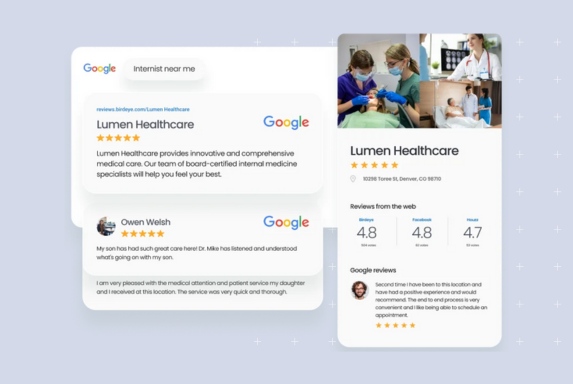
Why do doctors need SEO?
Patients are searching for healthcare providers online, and Google is their go-to source. According to Birdeye’s Online Reviews Report 2023, 47% of all local business searches are related to healthcare. So, ff your practice isn’t leveraging SEO, you risk losing potential patients to competitors.
With doctor SEO strategies, medical practices can:
- Attract local clients: Local SEO ensures you rank for searches like “dentist near me” or “best pediatrician in <locality>,” directing nearby patients to your practice.
- Enhance online reputation: Higher rankings on local searches showcase positive reviews, build credibility, and strengthen your online reputation.
- Increase site visits: Birdeye’s study on the state of Google Business Profiles shows that optimized and verified profiles see an increased volume of website visits, profile interactions (calls/messages), and appointments.
- Improve patient experience: By providing clear, accessible information online, you make it easier for people to reach you easily. No more searching for a phone number.
Doctor SEO strategies vs. PPC
Doctors often wonder whether they should invest in SEO or pay-per-click (PPC) advertising. Let’s consider the merits and demerits of these lead-generation strategies.
PPC delivers immediate results. However, SEO provides sustainable, long-term growth by improving organic rankings on search engines. Potential patients may also trust organic results more than paid campaigns, making it more fruitful to invest in building a holistic presence across search engines and social media.
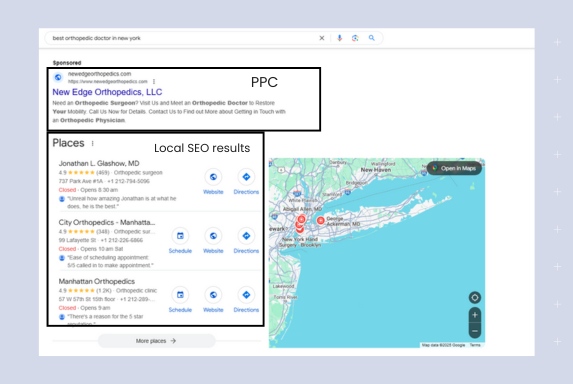
With SEO, doctors and medical practices can generate leads and convert them faster by showcasing social proof, establishing topical authority, and engaging with clients across multiple channels. This is significantly more important in cosmetic and other elective high-value procedures.
You can leverage top-performing SEO content for paid campaigns, generating more clicks and reducing advertising spending.
A balanced strategy may include both, but focusing on SEO ensures consistent visibility and better ROI over time.
How to build an effective SEO strategy for doctors
1. Conduct a local SEO audit
A local SEO audit is the foundation of improving your online visibility. This lets you know where you stand and systematically improve your local online presence.

- Start by reviewing your listings across Google Business Profile (GBP), Apple Business Connect, Facebook, and other niche sites to ensure accuracy in business information.
- Assess your local keyword rankings, customer reviews, and backlinks from other local websites.
- Compare your performance against local and global competitors to identify opportunities in SEO.
- Audit the website to spot and fix any existing SEO issues.
Birdeye Listings AI allows you to track, compare, and monitor keyword performance across multiple locations. It helps you ensure your listings are complete, accurate, and optimized from a centralized dashboard.
2. Analyze competitors
Understanding your competition is key to standing out in your market.
Start by identifying top-performing medical practices in your area and analyzing their websites. Examine their keyword strategy, blog topics, and backlink profile to discover tactics you can adopt or improve.
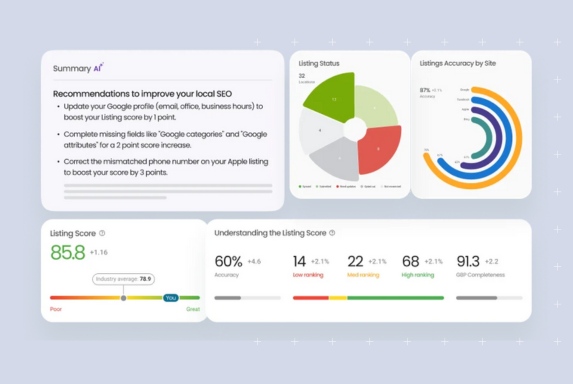
Additionally, review customer testimonials, online reviews, and social media activity to gain insights into patient preferences and trending content.
This analysis allows you to refine your approach, giving you a competitive edge in the search engine results pages (SERPs).
3. Conduct a market study
Understanding the needs of your potential clients is crucial. Research what medical services are in demand in your area and tailor your SEO strategy accordingly. For example, if you’re a pediatrician, determine if parents in your community search for phrases like “child check-ups near me” or “best pediatrician in [city].”
Use platforms like Google Trends and forums to identify common questions and concerns that can inform your website content. A targeted market study ensures your SEO strategy aligns with client needs and local demand.
4. Choose location-specific keywords
Location-specific keywords improve your visibility and attract highly relevant traffic to your website. These keywords should combine your medical specialty with location identifiers, such as “cardiologist in Los Angeles” or “family doctor near Austin.” Here’s how you can do this:
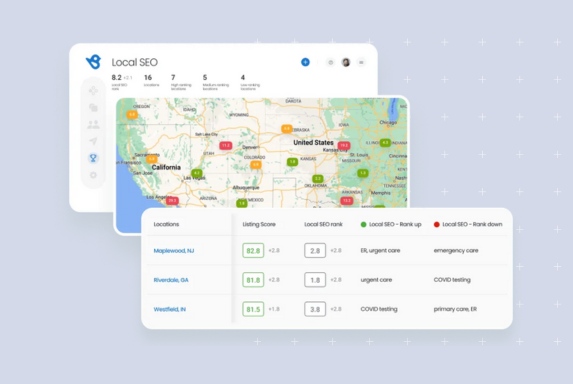
- Identify high-volume, low-competition keywords relevant to your area.
- Incorporate these keywords naturally into your website’s pages, including service descriptions, blog posts, and meta tags.
5. Set up reporting dashboards
Tracking your progress is essential to measure the success of your practice’s SEO strategy. Ensure you consistently monitor metrics such as website visits, click-through rates, and bounce rates. Setting up custom dashboards lets you see how well your keywords perform, which pages drive the most traffic, and where visitors convert into appointments.
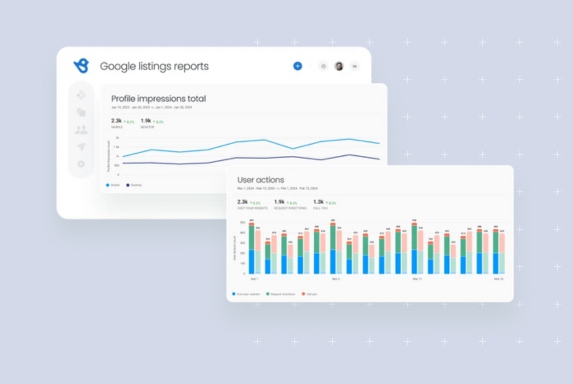
Regularly reviewing this data helps you fine-tune your strategy and handle any SEO issues, ensuring your efforts remain focused and effective.
Top doctor SEO strategies to boost local visibility and authority
Implementing strong doctor SEO strategies, clinics, and medical practices can ensure higher visibility and local authority. Some of the top strategies to follow include:
- Optimizing Google Business Profile (GBP)
- Building a presence on niche review sites
- Investing in on-page SEO
- Strengthening your content strategy
- Investing in link-building
- Focusing on technical SEO
- Boosting your social media presence
Let’s explore these in detail.
1. Optimizing Google Business Profile
Your GBP determines your search engine ranking, especially for location-based search queries. The completeness and accuracy of your profile ensure that Google chooses your practice to be the most suitable for searchers.
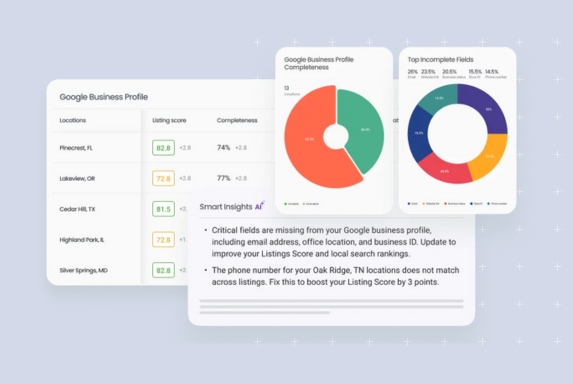
Here are a few things you can do to rank higher on local searches with Google Business Profile:
- Ensure NAP (Name, address, and phone number) consistency
- Add high-quality photos of your clinic
- Use the Q&A section to answer common questions.
- Connect your website, social media profiles, appointment calendar, and attributes (accessibility, language support, and more) to let patients know more about you.
- Actively generate and respond to reviews on your profile to showcase trustworthiness to patients.
2. Building a presence on niche review sites
Platforms like Healthgrades, Zocdoc, and RateMDs influence patient decisions. A presence here ensures that patients can easily find you, and Google can verify your details to rank you on relevant queries.
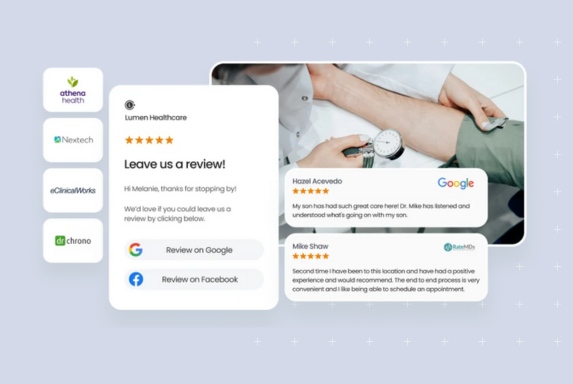
Claim and optimize your profiles on these sites by adding your credentials, specialties, and contact details. This will increase your credibility and help clients discover your practice when searching online.
3. Investing in on-page SEO
On-page SEO focuses on optimizing your website’s content and HTML to improve rankings, enhance user experience, and help search engines like Google and Bing find relevant information easily.
For effective doctor SEO strategies, medical websites should:
- Use relevant keywords: Incorporate keywords in titles, meta descriptions, and header tags. For example, include phrases like “affordable dentist in [city]” on service pages.
- Answer common questions: Create content that addresses patient inquiries and includes a clear call to action, such as scheduling an appointment.
- Link to local listings: Connect your website to local listing profiles to build topical authority and improve search visibility.
4. Strengthening your content strategy
Google and your potential clients need ways to evaluate your medical practice before choosing you over competitors. Creating relevant content that serves your audience can go a long way in facilitating this.
- Ensure your business creates educational and helpful content for your audience. This content should address common questions like “What to expect during a root canal treatment?” or “How to prepare for your annual physical exam.”
- Publish blogs on social media and Google Posts to ensure it reaches your target audience.
- Create a newsletter to distribute educational content to your existing and potential clients.

With content tailored for SEO, doctors can establish their authority and assure patients that they are the right choice for them.
5. Investing in link-building
Building high-quality backlinks from authoritative websites improves your domain authority and search rankings. Partner with local organizations, write guest blogs for health-related websites and participate in online forums to generate backlinks.
Scale your multi-location medical practice
Want to see the impact of Birdeye on your business? Watch the Free Demo Now.
6. Focusing on technical SEO
Technical SEO ensures your website is both user-friendly and search engine-friendly. Small behind-the-scenes optimizations can significantly improve your search rankings. Here’s how:
- Optimize your site speed, ensure mobile compatibility, and fix broken links.
- Implement schema markup to help search engines and readers understand your content better.
- Ensure that you regularly monitor technical metrics to fix any SEO issues that may come up.
7. Boosting your social media presence
Social media platforms like Facebook, YouTube, and Instagram can amplify your SEO efforts. Share updates about your practice, post health tips, and engage with your followers.
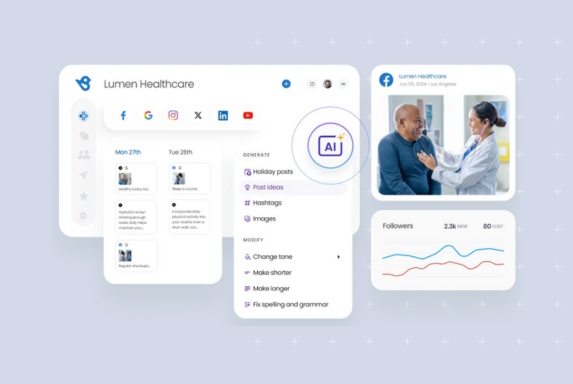
A strong social media presence drives traffic to your website and improves your overall visibility.
How to proactively manage your online reputation and patient reviews
Your online reviews are a powerful ranking factor and a primary driver of patient trust.
1. Systematically encourage patient reviews
Don’t just hope for good reviews; ask for them. The best time to ask is right after a positive experience. Use automated tools, like Birdeye Reviews AI, to send a review request via SMS or email shortly after a patient’s appointment.
2. Respond to every single review
For positive reviews: Thank the patient by name and mention something specific about their feedback. This shows you’re listening.
For negative reviews: This is an opportunity to demonstrate your commitment to patient care.
- Acknowledge their frustration and apologize for their experience.
- Take the conversation offline immediately. Provide a direct contact name and phone number (e.g., “Our practice manager, Ross, would like to discuss this with you personally. Please call her at…”)
- Never discuss personal health information, to comply with privacy regulations.
What is the most important part of SEO for a local doctor?
For a local doctor, the single most important element is your Google Business Profile (GBP). A fully optimized GBP with up-to-date information and a steady stream of positive reviews can have a massive impact on your visibility in local search results and on Google Maps.
3 best practices for on-page and technical SEO
Beyond just having a website, the health of its individual pages and its technical foundation are crucial for ranking. Here’s a checklist to ensure your on-page and technical SEO are in excellent shape.
1. Craft compelling page titles and meta descriptions
These are the first things a potential patient sees in Google search results. They need to be clear and compelling.
Page title formula: [Primary Keyword/Service] in [City/Neighborhood] | [Practice Name]
Example: Pediatric Cardiology in San Francisco | NovaStar Children's Hospital
Meta description: This is your 160-character ad. It should describe the page’s content and include a call to action.
Example: “Looking for a trusted pediatric cardiologist in San Francisco? Dr. Jane Doe at NovaStar Children’s Hospital offers expert, compassionate care for complex heart conditions. Book an appointment today.”
2. Optimize your website’s content and images
our content must be structured for both readers and search engines.
- Use header tags: Structure your content with a single
<h1>tag for the main title (e.g., “Our Dermatology Services”), followed by<h2>and<h3>tags for subheadings. - Optimize images: Large images slow down your site. Compress them before uploading. Also, use descriptive file names and “alt text” to tell Google what the image is about.
- Bad Alt Text:
image1.jpg - Good Alt Text:
Dr-Sunita-Patel-performing-a-routine-dental-check-up.jpg
- Bad Alt Text:
3. Implement schema markup for doctors (rich snippets)
Schema markup is code you add to your website to help search engines understand your content better. For a medical practice, this is a goldmine. It can result in “rich snippets” in search results, like star ratings, addresses, and operating hours appearing directly on Google.
Ensure your developer implements schema for:
Physician: To specify a doctor’s name and specialty.MedicalClinic: For practice-level information.Hospital: If applicable.RevieworAggregateRating: To showcase your patient ratings.
Bonus tip: Don’t forget video SEO
YouTube is the world’s second-largest search engine. Patients are increasingly seeking video content to understand complex medical topics and become more familiar with their doctors.
- Benefits of video: Build a personal connection, explain complex procedures simply, and stand out from competitors who only use text.
- Video ideas: Create short (1-2 minute) videos on topics like “What to Expect During Your First Visit,” “Dr. Tonk Explains Cataract Surgery,” or a tour of your clinic.
- Optimization is key: When you upload a video to YouTube, use your target keywords in the video’s title, description, and tags. Then, embed that video on the relevant service page on your website to increase engagement and time-on-page.
Conclusion
Having a strong SEO strategy isn’t just an option anymore for doctors or other healthcare professionals. It’s a necessity if you want your practice to stand out. When patients search for care, strong online visibility means more leads, greater trust in your expertise, and a better shot at winning them over competitors.
By nailing on-page and technical SEO, you can stay top of mind for your patients and keep your schedule full. It’s not just about being found—it’s about being chosen.
FAQs on Doctor SEO strategies
SEO is a long-term strategy. While you can see some initial results from local SEO optimizations within 1-3 months, it typically takes 6-12 months of consistent effort in content creation, link building, and on-page SEO to see significant, lasting improvements in rankings and patient traffic.
Local SEO ensures your practice appears in searches from nearby clients, driving more foot traffic and appointments.
Positive reviews build trust and improve local SEO rankings, encouraging new clients to choose your practice.
You can certainly start with the basics yourself, such as optimizing your Google Business Profile and requesting reviews. However, the more technical aspects like schema markup, link building, and in-depth content strategy often require specialized expertise. Many practices start with the basics and then hire an agency to take their results to the next level.
Boost your clinic’s online presence with Birdeye’s GenAI solutions
Running a clinic and actively focusing on SEO efforts can be quite resource-intensive. However, Birdeye’s GenAI solutions can help you streamline the multiple processes in search engine optimization and ensure you rank higher on the relevant local searches.
With Birdeye, you can stay ahead of the competition with:
- Listings AI – Audit local listing search rankings, ensure accuracy and completeness, and showcase the brand in the best possible light
- Reviews AI – Consistently generate reviews from all patients to showcase a positive customer experience and boost trust in the market.
- Insights AI – Analyze listing performance with a comprehensive Listing Score and get smart AI-generated recommendations for improvement.
With Birdeye powering your SEO, doctors like you can ensure success across all marketing efforts. Watch a free demo today to see it in action.

Originally published
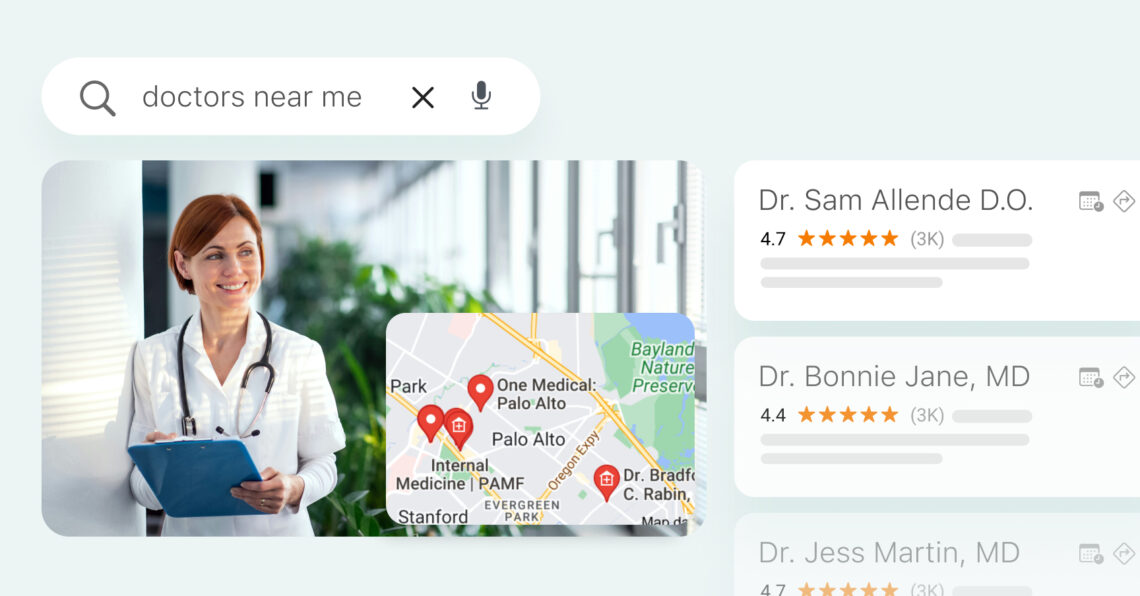

![[Feature image] Local SEO mistakes -what’s holding your business back from ranking locally](https://birdeye.com/blog/wp-content/uploads/Feature-image-Local-SEO-mistakes-whats-holding-your-business-back-from-ranking-locally-375x195.jpg)






